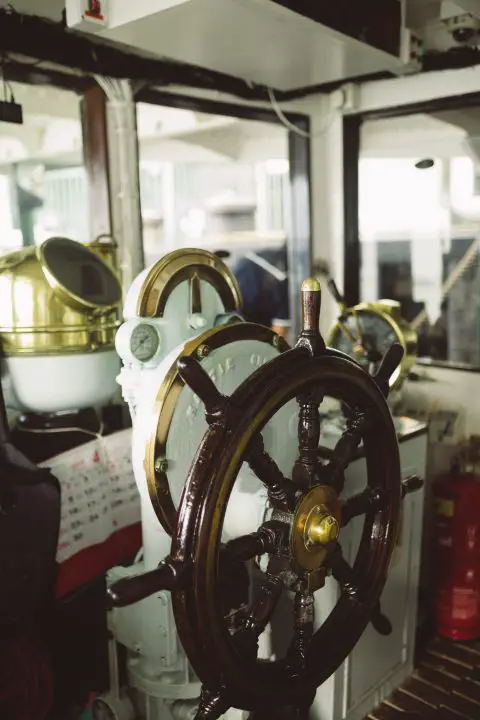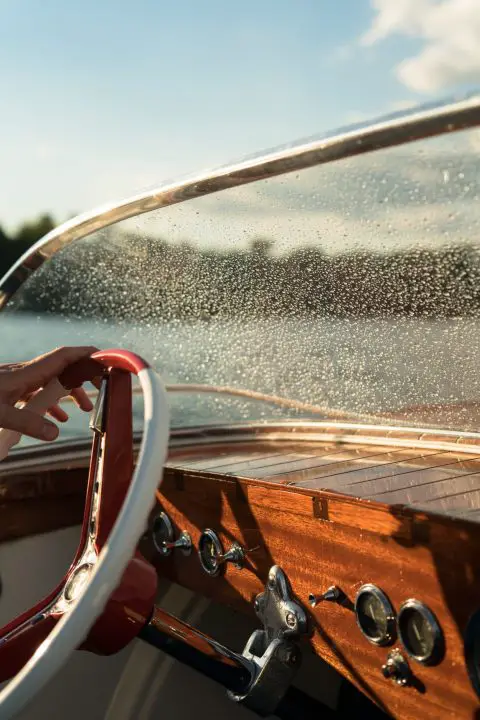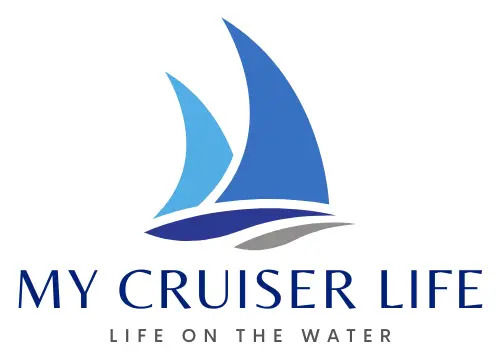Here’s another one of those terms that sounds simple to define but is actually a bit more complicated. Most people know that the helm is the place from which the skipper steers the boat, but did you know that it is also the name of the steering wheel itself?
Table of Contents
What is the Helm of a Boat?
A boat helm describes the mechanism that attaches to the rudder or steering device. Whether it is a steering wheel or tiller, the helm directs the rudder, which steers the boat. The helm on a boat often has navigation and communication devices nearby and is the command and control center.

Helm Types
There are a multitude of boat designs that all have different helm arrangements. For example, an eight-foot sailing dinghy will likely have a tiller to steer the boat. On the other hand, a 1,200-foot-long aircraft carrier will have a very advanced helm station with electronic controls, navigation equipment, and communication equipment.
Wheel Steering
When answering, “What is a helm on a boat?” many boaters would answer by describing a traditional wheel while imagining Captain Sparrow at the helm.
Wheel steering is one of the more popular ways to steer a boat. The wheel is connected to a mechanical or hydraulic system that controls the rudder. The wheel is attached to the helm, which is the device that converts the wheel’s steering motion into a push-pull motion on the steering cable. The helmsperson steers the wheel, and the cable turns around the boat’s helm. The push-pull cable controls and moves the rudder.
Larger boats might have more than one steering cable to handle the extra forces.
Mechanical Steering Helms
Mechanical steering is popular on smaller boats. A rack and pinion helm has a pinion gear on the steering shaft that engages a rack gear. More common, however, is a simple pulley and cable system that moves the rudder post. So long as the rudder is well designed and balanced, it requires very little force to move the helm.
Hydraulic Steering
Hydraulic steering systems provide powerful torque with little effort from the helmsperson. When the wheel is turned, a hydraulic piston is activated and moves fluid through the system. The helm converts the rotating steering action into a push-pull motion on the steering linkage. The steering cable moves the rudder. This type of system is used in places where the rudder will take significant force to move, and it’s also a popular way to turn large outboard motors.
Hydraulic steering also includes a cylinder that moves after the wheel turns. If you’re looking at installing an upgraded system, there are many on the market including Seastar Helms hydraulic steering systems.

Tiller Steering
The tiller is a long pole attached to the top of a rudder. The helmsperson pushes the tiller to the left or the right, and this force directly moves the rudder and steers the ship. Tiller steering can be confusing at first for those used to wheel steering. When a helmsperson turns a wheel to the left, the boat moves to the left. When a helmsperson moves a tiller to the left, the boat goes to the right. In nautical terms, if the tiller is moved to port, the boat moves to starboard.
Tiller steering is very simple and a good option if you want to save money.
Tiller steering is usually seen on smaller boats, from eight-foot dinghies to 30-foot sailboats. Most larger boats have steering wheels. However, in some cases, larger boats do have tiller steering, and some very small boats have wheel steering.

What is a Boat Helm Like?
While the helm is technically the mechanical device that controls the boat’s rudder, many skippers, captains, and helmspeople include all the boat’s control mechanisms when referring to the helm. For example, the helm is the steering wheel, but it can also refer to the navigation and communication equipment.
Each boat has a different helm set-up customized by the owner or captain. On small, simple boats, the helm station might just include the steering wheel and a compass. Or larger, more complicated boats, the helm station will have a radio, navigation equipment, a radar display, and other instruments.
Sailboat Helms
Smaller sailboats often have tiller steering. If you have a small sailing dinghy, the helm might just be the tiller, with no compass or additional equipment. On such a small vessel, the helmsperson is likely to be seated next to the tiller.
On larger sailboats, steering wheels are more common. In addition to the steering wheel, the helm is likely to have more equipment. A large compass for navigation is likely. Sailboat helms often have a radio mounted nearby for easy communication with other boats. Sailboat helms may have displays showing wind speed, direction, boat speed, and water depth. More advanced systems might include a radar display and charts with GPS.
Most larger sailboats are designed so that the helmsperson can sit or stand at the helm. The helmsperson should be able to be comfortable for long periods. In addition, the helmsperson should have a good view and see in front, behind, and to the sides of the boat. A helm with 360-degree views will help the helmsperson navigate while seeing and avoiding traffic and hazards.
Some sailors like to have all sail control lines led back to the helm station. This means that the sailor can raise, lower, and control the sails from the helm.
Power Boat Helms
On a smaller powerboat, the helm controls the outboard motor. The helm connects to a steering cable or a hydraulic system that moves the outboard motors. The outboard motors steer the boat. Larger powerboats might have several outboard motors, an inboard engine, or one or many diesel engines.
Powerboats often have wheel steering. If the powerboat has outboard engines, the steering wheel controls the engines, which move to provide vectored thrust. If a powerboat has an inboard engine or multiple inboard engines, the boat’s rudder steers the boat. The wheel connects to the steering cables or hydraulics, which turn the rudder.
Like larger sailboats, larger powerboats will also have additional equipment and devices at the helm. For example, a large cruiser like a Sea Ray may have a compass, GPS navigation, speed instruments, radar, and fish-finders.

Pilothouse Helms
On many boats, the helm position is outside in the elements. Most sailboats and powerboats have biminis to protect the helmsperson from the sun. Some even have complete enclosures that protect the crew from sun, rain, and wind. Some boats have pilothouse helms, which allow the helmsperson to steer from inside a protected area. A pilothouse helm offers maximum comfort and protection from the elements.
Common Helm Features
Bow Thruster Steering
Some boats have bow thrusters in addition to engines. The bow thruster is located in the bow and provides additional turning help in close-quarter maneuvering. A joystick button usually controls the bow thruster. If the boat has a single inboard engine, it is also not uncommon for it to have both a bow and a stern thruster.
Joystick Helm for Boat
Joystick controls represent the latest boat steering technology. Joystick steering is most commonly seen on outboard powerboats and megayachts.
Joystick steering provides intuitive steering. The helmsperson can easily steer the boat forward, backward, or sideways. The joystick is tied to a fly-by-wire computer control system that figures out the correct power and steering inputs to make the yacht go in any direction for easy docking.
Helm Seating
Helm seating is important to ensure that the helmsperson is comfortable throughout their watch. Helm seats often have cushions and might even have backrests. In addition, some helm seats are elevated to provide better visibility. On leisure boats, companion helm seats are popular.
Autopilot
Larger boats and ships will have an autopilot. A sailboat autopilot steers the boat and relieves the helmsperson from having to hand-steer the boat constantly. The autopilot might be wheel-mounted or below-deck mounted. They can be connected to the steering system with a cable, link, or hydraulics. Autopilots often just steer for a heading, such as North or 360 degrees. But some advanced autopilots can follow sailing directions, such as sailing 90 degrees relative to the wind. Advanced autopilots can also follow turn-by-turn directions from the GPS navigation system.
What is the Helm of a Ship?
On a traditional sailing boat, the helm is usually a large steering wheel. A traditional ship’s helm is made from wood and has eight spikes. A traditional wooden steering wheel also has notches or a Turk’s head knot to indicate the center of the wheel. This is handy, as skippers can either see or feel the center of the wheel and know immediately whether the rudder is centered or not.
Take The Helm
Have you ever heard someone say, “Take the helm?” Usually, this phrase refers to taking control of something. For example, your boss might want you to take the helm of a new product development project. But there’s nothing half so much fun as actually “taking the helm” of a boat.
When you take the helm of a boat, you are in control of steering it. You must ensure the boat’s safe operation and ensure you aren’t on a collision course with any other vessels or hazards. When you take the helm, keep a lookout ahead and behind you.
The helm of a boat is one of the most important places on a boat. From the helm, the helmsperson steers the boat and controls the rudder. The helm also has any navigation and communication equipment. The boat’s helm can be considered the command center for the boat and is vital to an eight-foot dinghy or a 1,200-foot aircraft carrier. Whichever boat you skipper, there’s nothing like taking the helm and pointing your bow to the far horizon.
Boat Helm FAQs
How does a helm work on a boat?
A helm is a device that steers the boat. Boats use two different methods to connect to the helm, move the rudder, and turn the boat. The most commonly used method is the steering wheel. The steering wheel connects to the helm, which connects to a steering cable that turns the rudder.
A tiller is another method of controlling the helm. The tiller connects directly to the rudder and steers the boat.
What is a boats steering wheel called?
A boat’s steering wheel is often called the ship’s wheel or boat’s wheel. It can also be called the helm or helm station.
